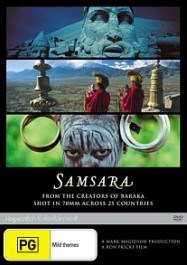Samsara (2011) |
|
Samsara (2011) |
|


|
| BUY IT |
| General | Extras | ||
| Category | Documentary | None | |
| Rating |

|
||
| Year Of Production | 2011 | ||
| Running Time | 98:07 | ||
| RSDL / Flipper | RSDL (49:06) | Cast & Crew | |
| Start Up | Ads Then Menu | ||
| Region Coding | 4 | Directed By | Ron Fricke |
|
Studio
Distributor |
Entertainment One | Starring |
Balinese Tari Legong Dabcers Ni Made Megahadi Pratiwi Puti Sri Candra Dewi Putu Dinda Pratika Marcos Luna Hiroshi Ishiguro Olivier De Sagazan Ladyboys of Cascade Bar Kikumaru Crisanto Neire Robert Henline |
| Case | Amaray-Transparent | ||
| RPI | $29.95 | Music |
Marcello De Francisci Lisa Gerrard Michael Stearns |
| Video | Audio | ||
| Pan & Scan/Full Frame | None |
Audio Dolby Digital 5.1 (448Kb/s) Audio Dolby Digital 2.0 (224Kb/s) |
|
| Widescreen Aspect Ratio | 2.40:1 | ||
| 16x9 Enhancement |
 |
||
| Video Format | 576i (PAL) | ||
| Original Aspect Ratio | 2.40:1 | Miscellaneous | |
| Jacket Pictures | No | ||
| Subtitles | None | Smoking | No |
| Annoying Product Placement | No | ||
| Action In or After Credits | No | ||
Samsara (2011) is the latest non-narrative film from Ron Fricke, the director of Baraka (1992) and the cinematographer of Chronos (1985). The film's official website describes Samsara thus: “Samsara is a Sanskrit word that means ‘the ever-turning wheel of life’ and is the point of departure for the filmmakers as they search for the elusive current of interconnection that runs through our lives. Filmed over a period of almost five years and in twenty-five countries, Samsara transports us to sacred grounds, disaster zones, industrial sites, and natural wonders. By dispensing with dialogue and descriptive text, Samsara subverts our expectations of a traditional documentary, instead encouraging our own inner interpretations inspired by images and music that infuses the ancient with the modern.”
Samsara can best be compared to a modern version of a Cinerama travelogue from the 1950s, without the narrative included, so that the music, which is mostly designed to appeal to the audience's aesthetic or spiritual senses, guides you to reflect upon the world around you. Samsara contrasts what is big and what is small in our world. We get to reflect on the natural world, the third world, and the industrialised world through slow-moving tracking shots, stills and sped-up time-lapse photography. There are some jarring comparisons here, such as the images of the ancient ruins and the hurricane Katrina-ravaged ruins of New Orleans’ Ninth Ward or the construction of plastic ‘real-dolls’ and images of strippers vapidly staring into the distance. There are some fascinating comparisons made with Chinese formations and synchronised prayer rituals photographed with meticulous detail. Again, assembly lines feature strongly, highlighting the mechanised nature of our societies. Some parts are disturbing, like one showing Olivier De Sagazan's improvised act as an employee in a business suit seated at his desk, applying make-up and transforming himself into a creature closely resembling that of the Pale Man in Pan’s Labyrinth. Overall, Samsara is an educational experience suitable for all members of the family - the type of film that promotes discussion about the world around us.
Samsara looks on life on Earth in a circular way, as in a cycle. The cycles of life, death, and rebirth, common ideas in Hindu and Ancient Native Indian religions show that the movements of creation and dissolution never stop. The film's meditative scenes include:
Conflict is another theme explored in Samsara. The filmmakers depict the world-wide demand for arms, violence, hatred and war with images and scenes of the following:
These images represent the dehumanisation that feeds conflict. This theme of dehumanisation is further explored through highlighting the disparity between the rich and the poor. This can be seen in the penthouses with their own swimming pools contrasted with scenes of children sitting on bricks in garbage strewn houses. Elsewhere, workers carry back-breaking loads at a sulphur mine while others do mindless and repetitive work in huge factories. We then see chickens and pigs in factory farms treated the same way (which begs the question - did the filmmakers encounter difficulty in showing these practices? Only in the United States, elsewhere they were welcomed!). The throwaway, affluent societies of the First World are mockingly shown through images of thousands of cars on busy Los Angeles highways, then compared to vehicles smashed and compacted into slabs of junk.
Having presented these confronting images, we come full-circle at the end of the film, exploring a mix of devotional rituals and practices including:
Samsara is a visual masterpiece, supported by an outstanding musical score by Michael Stearns, Lisa Gerrard, and Marcello de Francisci comprised of many different types of devotional music, chants and meditative orchestrations. With its visual beauty, its spiritual reflections, its depiction of the natural world, its images of war and conflict, Samsara is a confronting reflection on the life we all share on our planet Earth. Just as good as Baraka was in 1992, Samsara is, without doubt, one of the best films you'll see this year (and sense, hear and reflect upon after viewing!).
As mentioned, Samsara took five years to make in many locations within 25 countries. It was filmed using Super Panavision 70mm film (65mm negative size) and scanned digitally at 8k resolution. The film ended being 20 terabytes in size, so the image you witness on Blu-ray or DVD is only a tiny fraction of how sharp, clear and huge these images are!
The aspect ratio is 2:39:1, 16x9 enhanced for widescreen televisions.
Even with an average bitrate of 6.94 m/b per sec on this DVD, the video transfer is the best image transfer I've possibly seen for DVD, it is that clear and sharp!
Colour is vibrant and strong, there is an emphasis on strong primary colours in many scenes. Look out for reds, yellows and blues and how striking they look throughout the film.
There are no video artefacts to highlight here, or compression issues through the transfer to DVD either.
Because this is a non-narrative film, there is no need for subtitles.
The RSDL change occurs at 49:06, during a scene transition.
| Sharpness | |
| Shadow Detail | |
| Colour | |
| Grain/Pixelization | |
| Film-To-Video Artefacts | |
| Film Artefacts | |
| Overall |
Unlike Baraka, the score to Samsara was added after the film was edited silently. Composer Michael Stearns provides ambient music to augment the imagery. He is joined by vocalist/composer Lisa Gerrard, who was credited with co-composing parts of Baraka’s score along with her band Dead Can Dance, and composer/producer/music mixer Marcello De Francisci.
There are two audio tracks available, a Dolby Digital 5.1 track encoded at 448 kbps and a Dolby Digital 2.0 stereo track encoded at 224 kbps.
The musical score combines natural and man-made elements to envelop the sound of the world, usually in all channels!
The surround channel mix has great fidelity, directionality and is immersive.
Subwoofer effects are equally matched in their use, providing clear and deep sound when needed.
| Dialogue | |
| Audio Sync | |
| Clicks/Pops/Dropouts | |
| Surround Channel Use | |
| Subwoofer | |
| Overall |
There are no extras provided unfortunately! The Australian Blu-ray release of Samsara includes a 49-minute behind-the-scenes documentary which is split into six parts, however.
NOTE: To view non-R4 releases, your equipment needs to be multi-zone compatible and usually also NTSC compatible.
The Region 1 United States release includes the 49-minute documentary which covers various aspects of the film: The Concept, The Production, The Editing, The Musical Journey, The Technical Approach, and The Filmmakers.
Samsara is a beautifully crafted contemplative, meditative, and philosophical film. It addresses the many imbalances in the natural and man-made world with wonderful imagery and a superb supporting soundtrack. Even though the 49-minute documentary is not included, you will not regret viewing this on DVD. For those viewers who wish to view some behind-the-scenes footage, I suggest getting the Blu-ray release from the same distributor, Hopscotch films. Alternatively, you can get some interesting facts about the film from the homepage for Samsara here. If you enjoyed Baraka, you will no doubt enjoy Samsara too!
| Video | |
| Audio | |
| Extras | |
| Plot | |
| Overall |
| Review Equipment | |
| DVD | Sony BDP-S550 (Firmware updated Version 020), using HDMI output |
| Display | Samsung LA46A650 46 Inch LCD TV Series 6 FullHD 1080P 100Hz. Calibrated with THX Optimizer. This display device is 16x9 capable. |
| Audio Decoder | Sony STR-K1000P. Calibrated with THX Optimizer. |
| Amplification | Sony HTDDW1000 |
| Speakers | Sony 6.2 Surround (Left, Front, Right, Surround Left, Surround Back, Surround Right, 2 subwoofers) |